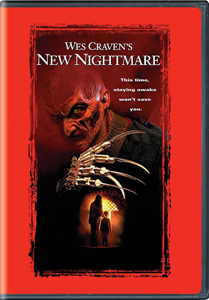From Sept. 18-Oct. 16, we’re looking back at the nine films of the “Nightmare on Elm Street” franchise. Next up is the seventh film, “Wes Craven’s New Nightmare” (1994):
Embracing meta-horror
Before “Scream” (1996), a few films tiptoed into meta horror, and one went into it full-tilt: Even more so than “Scream” itself, “Wes Craven’s New Nightmare” embraces the concept of the characters knowing they are in a horror movie.
Heather Langenkamp (Nancy in the first and third films) plays herself being stalked by a demon that has gained power by latching onto the popularity of the “Nightmare on Elm Street” films and Freddy Krueger in particular. And writer-director Craven plays himself writing this screenplay, based on his dreams.
It’s a great concept, certainly, but as a piece of entertainment, “New Nightmare” has nothing on what the “Screams” would later deliver. At nearly two hours, it’s at least 30 minutes too long. It’s short on personalities and comedy.
It starts with some mysteries – someone is phone-stalking Heather (the phone ringtone is a sneak preview of “Scream’s”) – but the answer to everything is “the supernatural,” as with every “Elm Street” film.
The biggest problem is that Heather and her young son, Dylan (Miko Hughes), get the bulk of the screen time but never command the screen. We get a parade of appearances from better actors – Robert Englund as himself, John Saxon as himself – but they are barely more than cameos.
Tracy Middendorf – later more entrenched in the Craven mythos as the mom in the “Scream” TV series — gets her first cinematic role here, and she’s good, but she’s only the best friend and babysitter.
A scarier Freddy
Freddy (Englund) is scarier, mainly due to the makeup job, but only nominally: He still does goofy Freddy things like extending his arms and sticking his tongue through phones. (The push to restore Freddy’s scariness gets taken up again, with better results, in 2003’s “Freddy vs. Jason.”)
Despite Englund telling Heather on the phone that he’s having visions of a darker version of Freddy, there’s not much sense of peril.
Granted, the sequence of Dylan crossing the freeway might have parents’ stomachs in their throats for a moment, but it’s too ridiculous to be taken seriously. It’s not believably staged. And if this were real life, Dylan and Heather would unquestionably be killed by wading into thick high-speed traffic at night.
“New Nightmare” is “real life,” at least in concept, so Craven takes the opportunity to touch on a few issues about Hollywood life, the creative process, and the moral responsibility of cinema.
Are kids watching horror movies at too young an age? Does writing about nightmares serve as a catharsis, or does it breed more nightmares? What’s it like to be considered a star for being in one surprise-hit slasher film? A generous reading is that these themes can be teased out of the subtext, but I found them to be passing mentions more so than commentaries.

Inconsistent tone
Langenkamp and Craven have incredibly lavish houses and are leading cushy lives. Good for them, but that means there’s none of the lower-class struggle of previous “Elm Streets.”
Heather (who, honestly, seems exactly like Nancy) deals with people who don’t believe Freddy is on the rise – Fran Bennett’s Dr. Heffner has a particularly bad bedside manner — but there’s no broader struggle to give her situation universal heft.
The scene where Craven outlines his screenplay to Heather is weirdly toned: He’s being kind of ominous, as if his nightmares have a bearing on reality, yet there’s no reason for him to truly believe that. I can’t tell if “New Nightmare” is winking or has something stuck in its eye.
Paving way for ‘Scream’
We know Craven can be a great director when he has great material – i.e. a Kevin Williamson screenplay – but when he’s helming his own work, well, it doesn’t work as well. “New Nightmare” is ostensibly set in the real world, but a handful of “real life” situations play falsely.
When Heather has to identify her husband (David Newsom) in the morgue, she wanders in by herself rather than being guided. Doctors and nurses make all sorts of decisions about Dylan’s treatment without consulting Heather. There’s a dream logic to some of this, but this is supposed to be as far from a dream as the “Nightmare” series has ever gotten.
I give Craven credit for trying. This meta concept is smart, and it fits well in a franchise that’s about the blurring and melding of different states of reality.
But you have to execute the concept, and “New Nightmare” too often bungles its attempt.
Click here to visit our Horror Zone.

“A Nightmare on Elm Street” series reviews
Friday, Sept. 18: “A Nightmare on Elm Street” (1984)
Wednesday, Sept. 23: “A Nightmare on Elm Street 2: Freddy’s Revenge” (1985)
Friday, Sept. 25: “A Nightmare on Elm Street 3: Dream Warriors” (1987)
Wednesday, Sept. 30: “A Nightmare on Elm Street 4: The Dream Master” (1988)
Friday, Oct. 2: “A Nightmare on Elm Street 5: The Dream Child” (1989)
Wednesday, Oct. 7: “Freddy’s Dead: The Final Nightmare” (1991)
Friday, Oct. 9: “Wes Craven’s New Nightmare” (1994)
Wednesday, Oct. 14: “Freddy vs. Jason” (2003)
Friday, Oct. 16: “A Nightmare on Elm Street” (2010)


